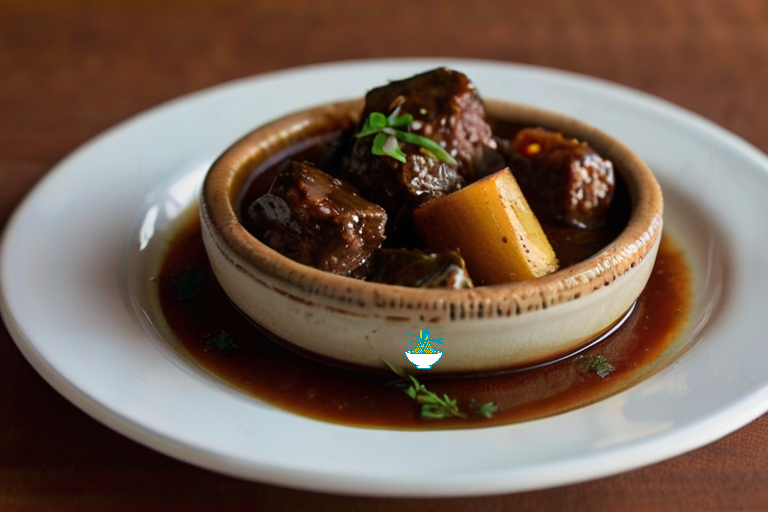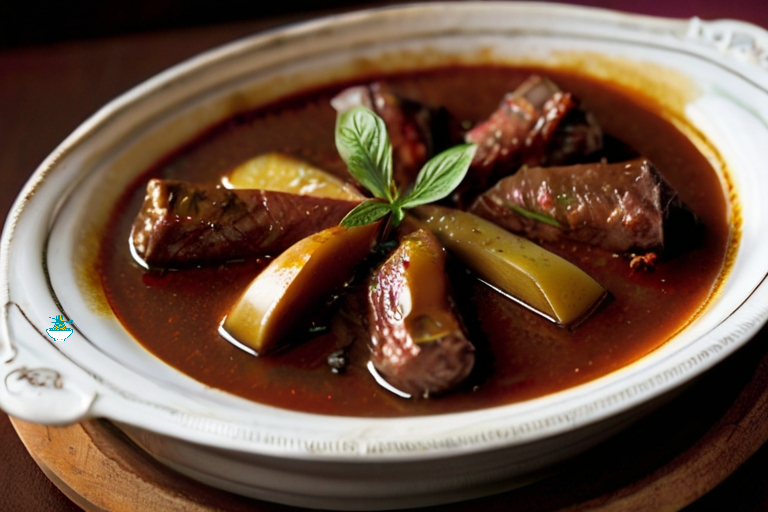Indulge in the rich flavors of Croatian gastronomy with Pašticada, a beloved dish hailing from the Dalmatian region. This culinary masterpiece features tender beef marinated in a symphony of red wine, vinegar, garlic, and a secret blend of spices, then slow-cooked to perfection. The complexity of this dish lies in its preparation, as it requires meticulous attention and patience to achieve its signature depth of flavor. Pašticada is typically served with homemade gnocchi or creamy mashed potatoes, allowing the savory sauce to complement every bite. Whether enjoyed as a comforting family meal or showcased at festive gatherings, Croatian Pašticada promises to delight the palate and evoke the warmth of Adriatic cuisine.
Here's a traditional recipe for Croatian Pašticada:
Ingredients:
For the marinade:
- 2-3 pounds (about 1-1.5 kg) beef (such as round or chuck), preferably tied with butcher's twine
- 2 cups red wine
- 1 cup red wine vinegar
- 1 onion, chopped
- 2 carrots, chopped
- 2 cloves garlic, minced
- 1 teaspoon black peppercorns
- 1 teaspoon cloves
- 1 teaspoon allspice
- 1 teaspoon juniper berries
- 2 bay leaves
- Salt, to taste
For cooking:
- 2 tablespoons vegetable oil
- 1 onion, sliced
- 2 carrots, sliced
- 2 tablespoons tomato paste
- 2 cups beef broth
- 1 cup water
- 2 tablespoons sugar
- 2 tablespoons red wine vinegar
- Salt and pepper, to taste

Instructions:
1- In a large bowl or resealable plastic bag, combine all the marinade ingredients. Add the beef and ensure it's completely submerged. Marinate in the refrigerator for at least 24 hours, turning occasionally.
2- After marinating, remove the beef from the marinade and pat it dry with paper towels. Strain the marinade and reserve the liquid.
3- In a large Dutch oven or heavy-bottomed pot, heat the vegetable oil over medium-high heat. Sear the beef on all sides until nicely browned. Remove the beef and set it aside.
4- In the same pot, add the sliced onion and carrots. Cook until softened, about 5 minutes.
5- Stir in the tomato paste and cook for another 2 minutes.
6- Return the beef to the pot and pour in the strained marinade, beef broth, and water. Add sugar and red wine vinegar. Season with salt and pepper.
7- Bring the mixture to a boil, then reduce the heat to low. Cover the pot and simmer gently for 3-4 hours, or until the beef is tender and the sauce has thickened. Stir occasionally and add more water if necessary to prevent sticking.
8- Once the beef is done, remove it from the pot and let it rest for a few minutes. Optionally, you can strain the sauce and blend it for a smoother consistency.
9- Slice the beef against the grain and serve it with the sauce, traditionally accompanied by homemade gnocchi, mashed potatoes, or pasta.
10- Garnish with parsley or lemon zest if desired, and enjoy your authentic Croatian Pašticada!
Nutritional Values:
Here's an approximate nutritional breakdown for the main ingredients used in the Pašticada recipe:
Beef (2-3 pounds):
- Calories: Approximately 1200-1800 kcal
- Protein: Approximately 150-225 grams
- Fat: Approximately 60-90 grams
- Carbohydrates: Negligible
benefits: Excellent source of protein, essential amino acids, vitamins B12 and B6, zinc, iron, and selenium, which are important for muscle growth, immune function, and overall health.
Red wine (2 cups):
- Calories: Approximately 400 kcal
- Carbohydrates: Approximately 20 grams
- Negligible protein and fat content
benefits: Contains antioxidants like resveratrol, which may help reduce inflammation and lower the risk of heart disease when consumed in moderation.
Red wine vinegar (1 cup):
- Calories: Approximately 50 kcal
- Carbohydrates: Approximately 10 grams
- Negligible protein and fat content
benefits: May aid in digestion, regulate blood sugar levels, and contribute to heart health due to its acetic acid content and potential antioxidant properties.
Onion (1 large):
- Calories: Approximately 45 kcal
- Carbohydrates: Approximately 11 grams
- Negligible protein and fat content
benefits: Rich in antioxidants, vitamins C and B6, and dietary fiber, onions may help boost immunity, reduce inflammation, and support heart health.
Carrots (2 large):
- Calories: Approximately 100 kcal
- Carbohydrates: Approximately 25 grams
- Negligible protein and fat content
benefits: High in beta-carotene, fiber, and vitamins A, K, and C, carrots promote eye health, support immune function, and may reduce the risk of chronic diseases like cancer and heart disease.
Garlic (2 cloves):
- Calories: Approximately 10 kcal
- Carbohydrates: Approximately 2 grams
- Negligible protein and fat content
benefits: Known for its antimicrobial and anti-inflammatory properties, garlic may help lower cholesterol levels, blood pressure, and improve overall cardiovascular health.
Tomato paste (2 tablespoons):
- Calories: Approximately 30 kcal
- Carbohydrates: Approximately 7 grams
- Protein: Approximately 1 gram
- Negligible fat content
benefits: Packed with lycopene, vitamin C, and antioxidants, tomato paste may help protect against oxidative stress, support skin health, and reduce the risk of certain cancers.
Beef broth (2 cups):
- Calories: Approximately 20-30 kcal (depending on whether it's homemade or store-bought)
- Negligible carbohydrates, protein, and fat content
benefits: Provides essential nutrients like protein, collagen, and amino acids, which support gut health, joint function, and may aid in post-exercise recovery.
Vegetable oil (2 tablespoons):
- Calories: Approximately 240 kcal
- Fat: Approximately 28 grams
- Negligible carbohydrates and protein content
benefits: Contains heart-healthy unsaturated fats and vitamin E, vegetable oil can help lower LDL cholesterol levels and reduce the risk of heart disease when used in moderation.
Sugar (2 tablespoons):
- Calories: Approximately 100 kcal
- Carbohydrates: Approximately 25 grams
- Negligible fat and protein content
benefits: While high in calories and carbohydrates, sugar provides quick energy, though excessive consumption should be avoided due to its association with obesity, diabetes, and other health issues.
Please note that these values are approximate and can vary based on factors such as the specific cut of beef, brand of ingredients, and cooking methods. Additionally, the nutritional values provided are for the listed ingredients only and do not include any additional garnishes or side dishes.


Comments